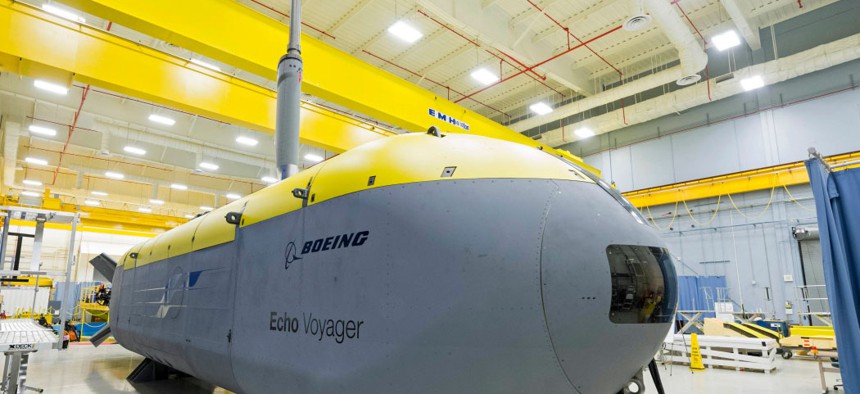Boeing's new autonomous UUV can run for months at a time
The 51-foot long unmanned Echo Voyager, which runs on a rechargeable power system, can operate without a surface support vessel.
The Navy, which has put a focus on unmanned undersea vehicles as part of its future fleet, now has another option, as Boeing has introduced its largest UUV to date, the 51-foot long Echo Voyager, which can operate on its own for months at a time.
The vessel, which has a hybrid rechargeable power system and modular payload bay, can also, unlike many UUVs, be launched and recovered without the help of a support ship, Boeing said in an announcement. The Voyager follows the company’s Boeing’s 32-foot Echo Seeker and the 18-foot Echo Ranger.
The Navy has explored using UUVs for underwater surveillance, mine-detection and other uses, testing them last year during an exercise in the Patuxent River in Maryland, for example. It already has several autonomous vehicles used for underwater ship-hull inspection and Defense Secretary Ash Carter said earlier this year that the Defense Department plans to spend $600 million over the next five years on UUVs.
Boeing, which has developed manned and unmanned underwater systems since the 1960s, said the Echo Voyager will undergo sea trials this summer off the coast of California. “Echo Voyager is a new approach to how unmanned undersea vehicles will operate and be used in the future,” said Darryl Davis, president of Boeing Phantom Works.
Unlike unmanned aerial vehicles, which can transmit ISR data and be operated via the airwaves, submerged vehicles often are tethered in order to maintain communications links. Boeing said Echo Voyager will be able to operate independently. “Echo Voyager can collect data while at sea, rise to the surface, and provide information back to users in a near real-time environment,” said Lance Towers, director of Sea & Land for Boeing Phantom Works. “Existing UUVs require a surface ship and crew for day-to-day operations. Echo Voyager eliminates that need and associated costs.”
Ultimately, the military is looking to develop an underwater network comparable to the way drones operate in the skies—or similar to the Interstate High System. The Defense Advanced Research Projects Agency issued a solicitation for technologies that could extend radio-frequency and electro-optical communications networks below the surface, rather than relying on low-frequency and low-data rate sound waves.





